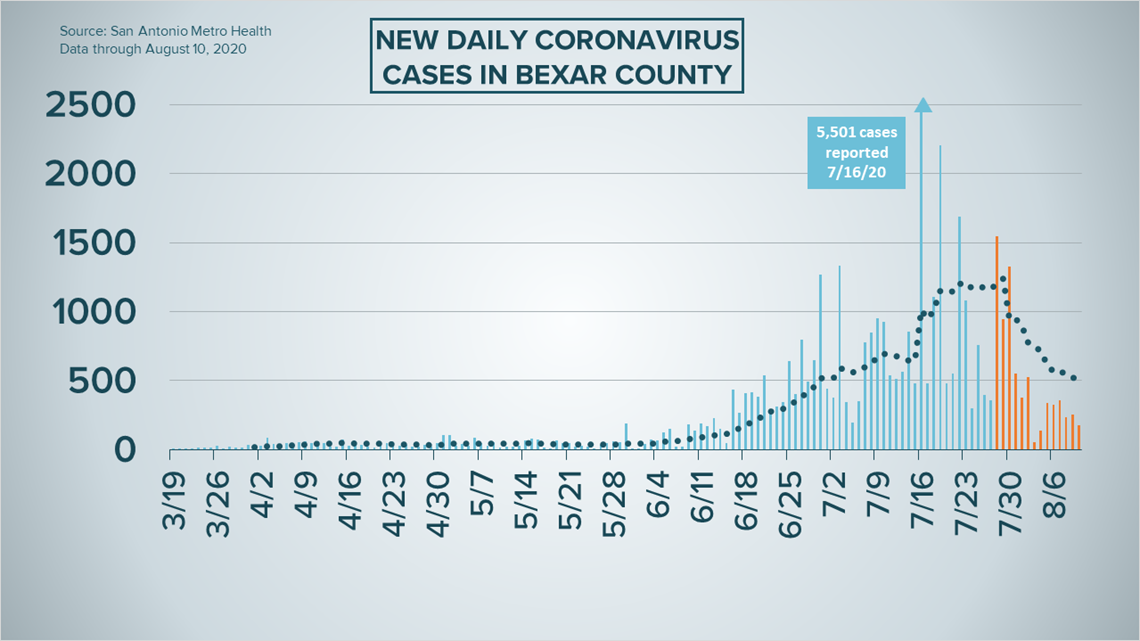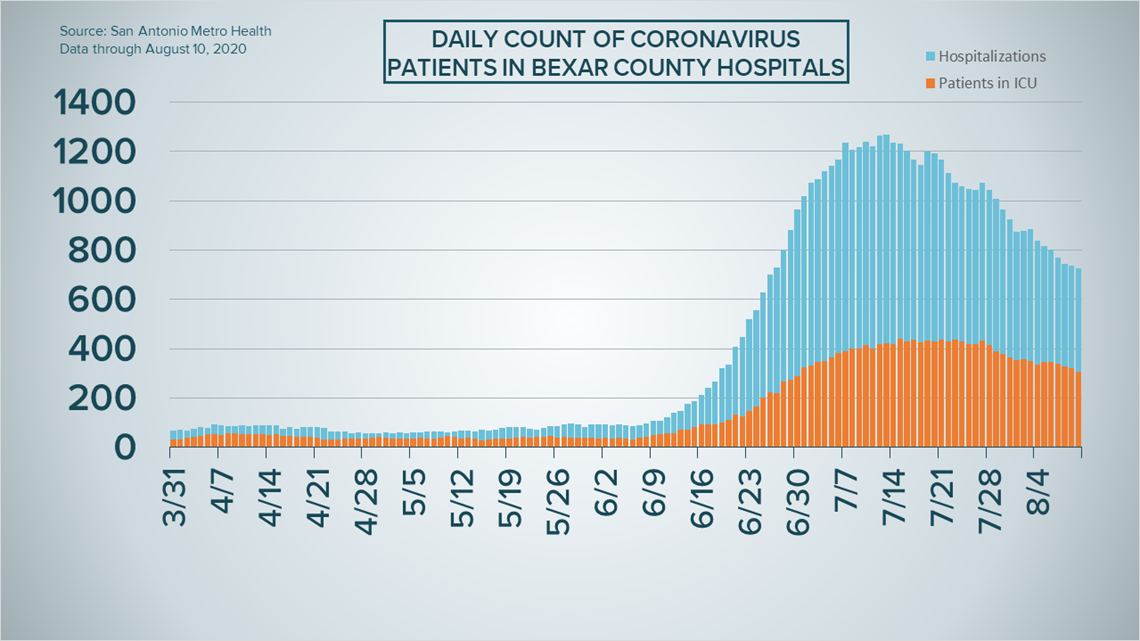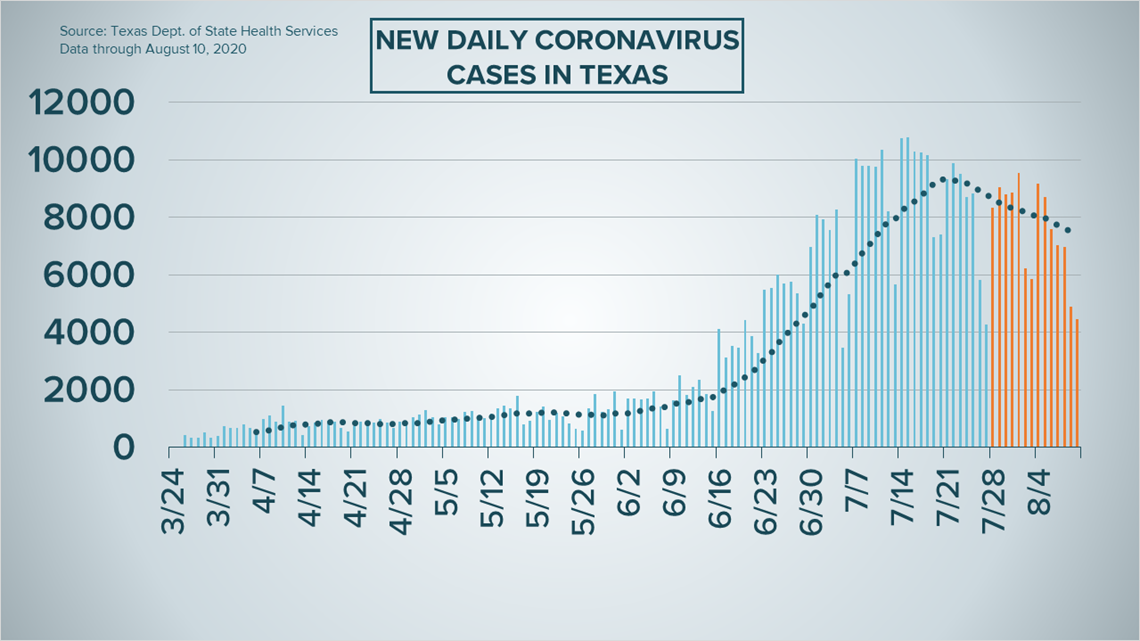SAN ANTONIO — We're tracking the latest numbers from the coronavirus pandemic in San Antonio and across Texas. Here are the latest numbers reported by Bexar and surrounding counties:
- Bexar County: 176 new cases were reported Monday, bringing the total number for the county to 42,959. The county death toll, meanwhile, rose to 455 after 10 additional fatalities were reported.
- Comal County: The county reported 27 new cases on Monday while its death toll rose by two. There have been a total of 2,386 cases of COVID-19 in the county -- including 1,839 confirmed cases -- while 62 county residents have died. County officials say there are 455 active coronavirus cases, and 1,869 residents have recovered.
- Hays County: Officials in Hays County on Monday reported 38 new cases in the county and one additional virus-related death. As of Monday evening, there were a total of 5,050 lab-confirmed cases in the county (2,787 of which were active) while the death toll rose to 35.
How Bexar County is trending
We're tracking how many coronavirus cases are confirmed in Bexar County each day from the time San Antonio Metro Health began reporting cases more than five months ago. Graphing those daily case numbers along a 14-day moving average provides an accurate picture of the curve in the San Antonio area and the direction we're heading amid the coronavirus.
On Monday, Mayor Ron Nirenberg reported an additional 176 coronavirus cases in Bexar County. Metro Health also reported 10 additional fatalities from coronavirus-related complications.
In all, 42,959 Bexar County residents have been diagnosed with COVID-19, and 445 have died from it.


Monday, Metro Health began reporting deaths under investigation alongside confirmed COVID-19 deaths in Bexar County. As of Monday evening, 327 deaths are under investigation for a possible coronavirus connection while 455 deaths have been confirmed by local health officials.
Hospitalizations in Bexar County continued their steady decline; 725 residents are currently hospitalized with coronavirus. 305 patients are in the ICU, while 216 are on ventilators. 15 percent of the county's hospital beds are available, while 50% of the county's ventilators are available.


Mayor Nirenberg noted that the city's COVID-19 risk level had dropped to "steady" from "severe," in what Bexar County Judge Nelson Wolff classified as "headed in the right direction." Nirenberg, however, noted that several factors -- such as the two-week decline in cases, testing capacity, contact tracing, and doubling rate -- needed to continue their positive trends in order for Bexar County schools to reopen safely.
Coronavirus in Texas
Texas health authorities on Monday reported an additional 4,455 new coronavirus cases from across the state. State health officials also reported an additional 31 virus-related fatalities on Monday.
In all, a total of 490,817 COVID-19 cases have been confirmed in the state, while 8,490 Texans have died from coronavirus complications.


On Monday, state officials reported that 7,437 Texans were receiving treatment for COVID-19 symptoms in state hospitals. There are 11,749 available hospital beds in the state, including 1123 available ICU beds. 6,596 ventilators are available in the state.
The number of Texans being tested for the coronavirus has fallen sharply in recent weeks, according to a report.
In the week ending Aug. 8, an average 36,255 coronavirus tests were administered in Texas each day — a drop of about 42% from two weeks earlier, when the average number of daily tests was 62,516.
The state's positivity rate, however, has increased dramatically since August began, rising to nearly 21%. Texas' positivity rate was at 12.05% to end July.
An estimated 349,833 Texans have recovered, while 133,584 remain ill.
State health officials said new case numbers for Nueces County were not posted on Monday. County health officials there were inundated with a "large backlog of positive lab reports" affecting their ability to report daily coronavirus numbers, Texas DSHS said. Data from the county will be reported Tuesday.
Latest Coronavirus Headlines
- More than 300 deaths in San Antonio investigated for possible coronavirus connection
- Comal ISD student tests positive for COVID-19 after attending band practice
- Over 97,000 children tested positive for COVID-19 during two weeks in July, study says
- Coronavirus testing in Texas plummets as schools prepare to reopen
- You can get a $50 gift card for donating convalescent plasma
- KENS 5 & Communities in Schools need your help to Stuff the Bus
Coronavirus symptoms
The symptoms of coronavirus can be similar to the flu or a bad cold. Symptoms include fever or chills, cough, shortness of breath or difficulty breathing, fatigue, muscle or body aches, headache, new loss of taste or smell sore throat, congestion or runny nose, nausea or vomiting and diarrhea, according to the Centers for Disease Control.
Most healthy people will have mild symptoms. A study of more than 72,000 patients by the Centers for Disease Control in China showed 80 percent of the cases there were mild.
But infections can cause pneumonia, severe acute respiratory syndrome, kidney failure, and even death, according to the World Health Organization. Older people with underlying health conditions are most at risk.
On June 25, the CDC expanded the list of groups at a higher risk of severe illness due to coronavirus.
Experts determined there was consistent evidence these conditions increase a person's risk, regardless of age:
- Chronic kidney disease
- COPD (chronic obstructive pulmonary disease)
- Obesity (BMI of 30 or higher)
- Immunocompromised state (weakened immune system) from solid organ transplant
- Serious heart conditions, such as heart failure, coronary artery disease, or cardiomyopathies
- Sickle cell disease
- Type 2 diabetes
The CDC believes symptoms may appear anywhere from two to 14 days after being exposed.
Human coronaviruses are usually spread...
- Between people who are in close contact with one another (within about 6 feet).
- Through respiratory droplets produced when an infected person coughs, sneezes or talks. These droplets can land in the mouths or noses of people who are nearby or possibly be inhaled into the lungs.
- Some recent studies have suggested that COVID-19 may be spread by people who are not showing symptoms.
Help stop the spread of coronavirus
- Stay home when you are sick.
- Eat and sleep separately from your family members
- Use different utensils and dishes
- Cover your cough or sneeze with your arm, not your hand.
- If you use a tissue, throw it in the trash.
Lower your risk
- Wash your hands often with soap and water for at least 20 seconds. If soap and water are not available, use an alcohol-based hand sanitizer.
- Avoid touching your eyes, nose, and mouth with unwashed hands.
- Avoid close contact with people who are sick.
- Clean and disinfect frequently touched objects and surfaces.
- The CDC recommends wearing a mask or cloth face covering if you have to be out due to an essential service or essential activity such as going to the grocery store.
- If you are 60 or over and have an underlying health condition such as cardiovascular disease, diabetes or respiratory illnesses like asthma or COPD, the World Health Organization advises you to try to avoid crowds or places where you might interact with people who are sick.

